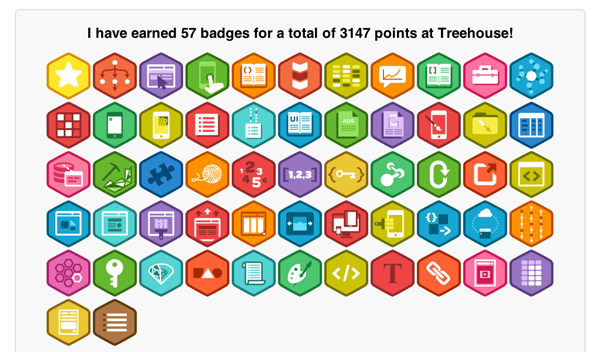Digital Credentialing and Gamification

Digital Credentialing is when you earn badges to show your achievements. This method of rewarding people for learning a new skill or achieving a goal allows you to see how you are progressing and the new skills that you have learnt in a visual way. The idea of badges originates from the scouts and guides that gave you a physical badge that you attached to your uniform to show a new skill that you learnt. This tradition has moved into the digital age and people will try and earn badges to show that they have successfully achieved a goal or learnt a new skill.
I have a Fitbit and when you meet a goal, such as walking a certain amount of steps you earn a badge. You get an email to congratulate you and the badge is displayed in your achievements and badges menu. The badges put what you have achieved into perspective and compare it to real life situations that make you feel proud of what you achieved by walking a certain amount of steps, or climbing a certain number of floors. An example of this would be the Italy badge that means you have walked 1,184 kilometers which is equivalent to walking the entire length of Italy.

Fitbit has designed 101 badges that you can work towards achieving. The badges allow you to recognise and help you to celebrate your journey towards health. Along your way you are earning badges to allow you to see how well you are doing and push you to want to achieve more. Rewarding people for their work encourages them and keeps them motivated to do better.

“When you’re as determined as so many Fitbit users are, it can be easy to get laser focused on your end goal. But while high aspirations are commendable, experts also say having smaller specific, measurable, and attainable goals can help keep you motivated. Another key factor? Rewards.”
- Danielle Koseki
Another company that uses badges successfully is Treehouse . Treehouse is an online learning platform that enables you to learn a range of different technologies. Treehouse believe that by incorporating badged in to a mobile or web application will challenge the users and encourage them to set goals. To achieve a badge you need to complete various different tasks. You are motivated to complete the tasks to achieve the badge, which improves self-motivation.

Treehouse believes that providing badges is verification of a job well done. Once you have completed the tasks, passed the quizzes and watched the videos relating to a particular topic you are awarded with your badge. You need to complete various different tasks to get certain badges meaning that people have a goal to work towards as well as rewards of completing tasks along the way. When users have a goal to work towards and build a reputation of gaining badges they will strive to maintain this. People want to improve or maintain their current reputation, therefore will strive to do so.

”Humans are instinctively competitive, so collecting badges can be motivating and exciting to unlock.”
- Danielle Koseki
Fitbit also use the fact that we are competitive by nature to encourage us to improve our fitness. They do this through allowing us to add our friends and start competitions to see who can walk the most steps. There is a strong feeling of community with both fitbit and Treehouse which encourages users to continue to work harder. You can share the badges that you earn on social media and people can see your badges on your public profiles.
Staff in the care industry often feel overworked and undervalued. This began to make me wonder is there a way that you could reward staff for their work in a way that is interesting and factual, and could this improve staff moral?
“Healthcare assistants are undervalued, increasingly overworked and not getting the support they need at work.”
There has been research into gamification in the workplace that shows it can improve the workforce. The research shows improvement in staffs ability to solve problems, staff motivation and the desire to develop their skills. This made me consider that badges would be good to reward staff with whilst they are training on how to use the system. This means that they can be awarded badges for different things that they do, such as completing records or adding in a certain amount of meals.
“The psychology behind gamification is that it uses regular and consistent positive feedback – points, badges, status, progression, etc. – to build up the users’ motivation.”
I believe that staff feeling undervalued is an issue in care industry. Numerous articles have been written over the years expressing how staff feel pressured in the workplace and are frustrated by the lack of career progression. I thought badges would be a good way of showing how much staff are learning and what they are trained in. They could have an area within the system that shows the badges that they received in relation to their career. It also enables staff to see their own progress and how much they are achieving in the workplace. Care workers deserve a lot of respect and recognition for what they do, and I believe this is something that gamification can help with.
